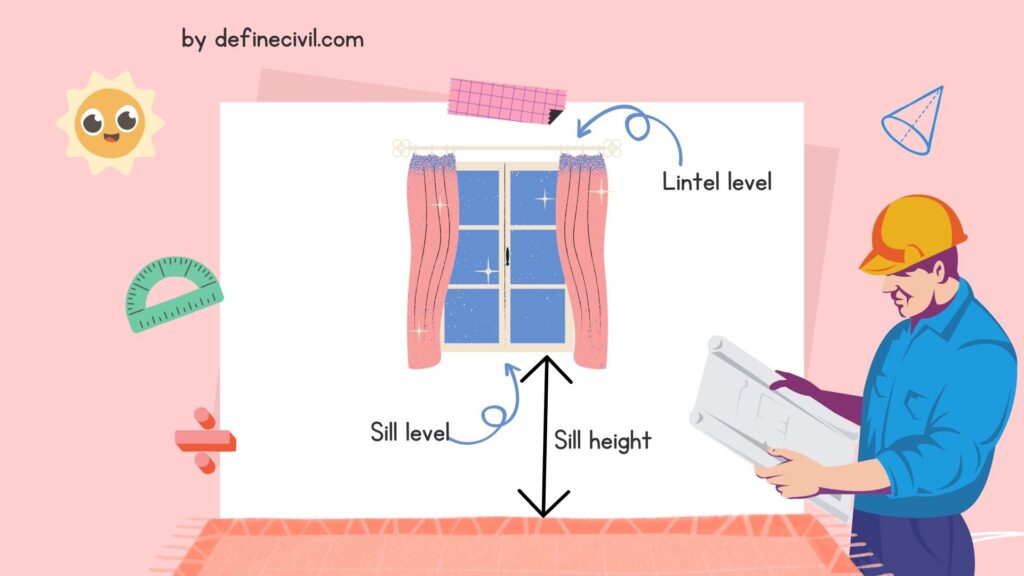The terms sill level, plinth level, and lintel level are all common in the world of home building and construction. These different types of levels are used by carpenters, engineers, and architects to ensure that structures are built according to blueprint specifications and are structurally sound. So, while working on the building construction projects, you will encounter these level several times; so it is good to know their purpose and differences.
Sill level and plinth level sound like they might mean the same thing, but each has a different purpose—and figuring out which one you need to know about can help you avoid costly mistakes later on down the road!
This guide will break down what sill level, plinth level, and lintel level are and when you need to worry about them in your home remodeling project.

What is sill level?
In building construction, sill level meaning to a horizontal plane or surface that coincides with beam or base of the windows or door frame. That’s why sill level is synonymous to window sill or sill band. This level is somewhat higher in elevation than plinth level and the reference is always taken from the road level or floor level. Generally, it is kept 0.9 meters high above the floor level.
In most of the building construction, sill beam of the window is made with RCC, PCC, mortar, wood or steel. The width of the window sill is greater or equal to the window of the brickwork below the level. The height of sill is equal to the height of the window.
Sill level plays an important role in residential and commercial building codes.
Also Read: Lintel Beam – Uses – Types
Sill Height
When referring to a specific vertical measurement, sill level is often called sill height.
Sill height is the difference between the floor level and the sill level. In other terms, sill height is the measurement between finished floor and the base of the window.
Sill level vs plinth level
The main difference between these three levels is how they’re used in residential and commercial construction—and their placement. To understand, you can refer to two planes: the ground plane and another reference plane above it.
In any building construction or home renovation, it is important to take proper care of sill level height and plinth level height at each stage in construction.
Sill level and plinth level are essential points that need to be calculated while designing a building. So, they affect various sections of walls during construction, especially exterior walls with openings like doors and windows. You need to framed doors and windows properly before concrete slab can be poured on ground floor as they lie directly on these levels.
Also Read: What is plinth Beam -Purpose – Application
| Sill level | Plinth level |
| Sill level is measured from top surface of foundation wall to bottom of opening in masonry walls (level with first course of opening) | Plinth level is measured from top surface of finished floor to the top of the natural soil adjacent to the road. |
| Sill coincides with bottom of the window or door opening | Plinth coincides with the top of the finished floor. |
| Normal sill level is 0.6 to 1.1 meter. | Normal plinth level is 0.25 to 0.45 meters. |
| The purpose of sill level is to protect the inside of the building from rain water coming directly from the window. It also protects the junction of the window and provides support or stability. | The purpose of plinth or plinth level in building is to prevent the ingress of water, dampness, or seepage from rainwater or surface water flowing towards the building. |
Sill level vs lintel level
The lintel level is a point on a wall directly beneath the lintel beam. This beam provides an opening for the window or the doors to be installed.
Lintel level will depend on your structure and specific installation, but it is typically found at about two feet from either side of an entryway door jamb or other overhang.
You need to know the exact lintel level while looking to build a doorway for an interior wall or a window in your home. Lintel level is also roughly where you should place studs for your frame if you plan to install drywall over it.
For architectural purpose, we made equal the top of the window or door opening – i.e. the lintel level.
| Sill level | Lintel level |
| Sill height is measured from top surface of foundation wall to bottom of opening in masonry walls (level with first course of opening) | Lintel height is measured from top surface of foundation wall to top of the opening in masonry wall (level of the first course above the window or door opening) |
| Sill coincides with bottom of the window or door opening | Lintel coincides with the top of the window or door opening. |
| Normal window sill level is 0.6 to 1.1 meter. | Normal lintel level is 2.1 to 2.2 meters. |

Also Read: What is a tie beam? – Details – Advantages
Selection of sill height of window
- The sill of the building must be above adjoining surfaces and floor level and below grade beams, which determines sill height.
- To determine sill height in your home, look for two clues.
- One clue is where your door frame hits inside your home and how you plan to install flooring material over it, such as carpet or hardwood floors.
- The other thing to look for is where your window trim will be placed inside your home.
- Window sill level for bathroom is greater than 1.1 meters to keep privacy. Anyhow, bathroom window height should be greater than what you have in other rooms of your house.
- However, living rooms and bedrooms, it is 0.5 to 0.6 meters. Obviously we don’t want the water to go out of the building during flooding.
Also Read: Types of Plaster – Finishing for walls – Interior



















